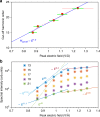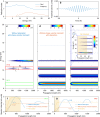Extreme-ultraviolet high-harmonic generation in liquids
- PMID: 30213950
- PMCID: PMC6137105
- DOI: 10.1038/s41467-018-06040-4
Extreme-ultraviolet high-harmonic generation in liquids
Abstract
High-harmonic generation (HHG) in gases has been the main enabling technology of attosecond science since its discovery. Recently, HHG from solids has been demonstrated, opening a lively area of research. In contrast, harmonic generation from liquids has so far remained restricted to low harmonics in the visible regime. Here, we report the observation and detailed characterization of extreme ultraviolet HHG from liquid water and several alcohols extending beyond 20 eV. This advance was enabled by the implementation of the recent liquid flat-microjet technology, which we show to facilitate the spatial separation of HHG from the bulk liquid and the surrounding gas phase. We observe striking differences between the HHG spectra of water and several alcohols. A comparison with a strongly-driven few-band model establishes the sensitivity of HHG to the electronic structure of liquids. Our results suggest liquid-phase high-harmonic spectroscopy as a new method for studying the electronic structure and ultrafast scattering processes in liquids.
Conflict of interest statement
The authors declare no competing interests.
Figures









References
-
- McPherson A, et al. Studies of multiphoton production of vacuum-ultraviolet radiation in the rare gases. J. Opt. Soc. Am. B. 1987;4:595. doi: 10.1364/JOSAB.4.000595. - DOI
-
- Ferray M, et al. Multiple-harmonic conversion of 1064 nm radiation in rare gases. J. Phys. B. 1988;21:L31–L35. doi: 10.1088/0953-4075/21/3/001. - DOI
-
- Krausz F, Ivanov M. Attosecond physics. Rev. Mod. Phys. 2009;81:163–234. doi: 10.1103/RevModPhys.81.163. - DOI
-
- Calegari F, Sansone G, Stagira S, Vozzi C, Nisoli M. Advances in attosecond science. J. Phys. B. 2016;49:062001. doi: 10.1088/0953-4075/49/6/062001. - DOI
-
- Ghimire S, et al. Observation of high-order harmonic generation in a bulk crystal. Nat. Phys. 2011;7:138–141. doi: 10.1038/nphys1847. - DOI
Publication types
LinkOut - more resources
Full Text Sources
Other Literature Sources

